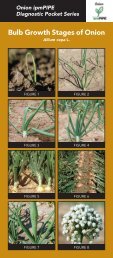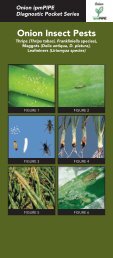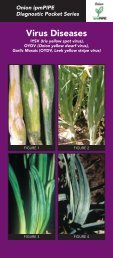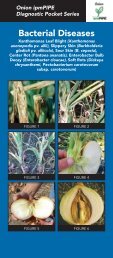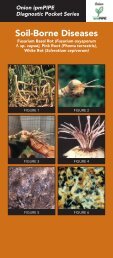Storage Fungal Diseases
Storage Fungal Diseases (pdf) - Washington State University
Storage Fungal Diseases (pdf) - Washington State University
- No tags were found...
Create successful ePaper yourself
Turn your PDF publications into a flip-book with our unique Google optimized e-Paper software.
Onion ipmPIPE<br />
Diagnostic Pocket Series<br />
<strong>Storage</strong> <strong>Fungal</strong> <strong>Diseases</strong><br />
Black mold (Aspergillus niger), Blue mold<br />
(Penicillium species), Gray mold or neck rot<br />
(Botrytis species), Fusarium rot (Fusarium<br />
oxysporum f. sp. cepae)<br />
Figure 1 Figure 2<br />
Figure 3 Figure 4<br />
Figure 5 Figure 6
Onion ipmPIPE<br />
Diagnostic Pocket Series<br />
<strong>Storage</strong> <strong>Fungal</strong> <strong>Diseases</strong><br />
AUTHORS: L. J. du Toit (Washington State University) and<br />
H. F. Schwartz (Colorado State University) PHOTOGRAPHS:<br />
Courtesy H. F. Schwartz, L. J. du Toit, and S. K. Mohan<br />
(University of Idaho) [01/2011]<br />
Common Hosts: Onion, Garlic<br />
Symptoms (on onion):<br />
Figures 1 & 2 • Black mold develops as black discoloration<br />
(usually at the neck), shallow lesions on outer scales, streaks<br />
of black mycelium and conidia beneath the outer dry scales,<br />
and black discoloration in bruised areas. Bulbs usually do<br />
not rot, unless secondary bacterial infection occurs.<br />
Figures 3 & 4 • Gray mold (neck rot) develops as a<br />
semi-watery decay, usually in the neck, that progresses<br />
down through the bulb. Fleshy scales soften and become<br />
water-soaked and translucent, with white to gray mycelium<br />
between scales. Gray to black sclerotia and gray mold may<br />
form on outer and inner scales.<br />
Figure 5 • Blue mold first appears as pale yellow<br />
blemishes, watery soft spots, and occasionally purple-red<br />
stain on scales. A green to blue mold may develop on the<br />
surface of lesions, there may be a light tan or gray color on<br />
the fleshy scales, and bulbs may become tough (punky) with<br />
a musty odor.<br />
Figure 6 • Fusarium basal rot starts in the field and can<br />
progress in storage from a dry basal plate rot to a dry rot of<br />
the fleshy scales.<br />
Factors Favoring:<br />
• Black mold is favored by harvest and storage >24°C<br />
(75°F); blue and gray molds, and Fusarium basal rot are<br />
favored by lower temperatures.<br />
• These diseases are favored by free moisture and high<br />
humidity (>75%) during harvest and storage.<br />
• These diseases are also favored by planting infected seed,<br />
transplants or sets; crop injury; and bruising of bulbs.<br />
Sponsored in part by:<br />
ADDITIONAL RESOURCES AVAILABLE AT:<br />
http://onion.ipmpipe.org<br />
http://wiki.bugwood.org/PIPE:Onion<br />
http://www.apsnet.org/ — Compendium of Onion & Garlic<br />
<strong>Diseases</strong> and Pests, 2nd Ed.



